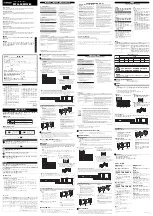
Chapter 2 Power Supply and Computer Installation
Other Computers with Non-Standard Serial Ports
Computers with non-standard serial ports must meet the following conditions:
♦
The signal levels must be compatible with RS-232-C. The DSP requires the voltage levels from the computer
be greater than +3 volts in the “asserted” state and 0 volts or less in the “non-asserted” state.
♦
The signal polarity must conform to the RS-232-C standard. The 0 or negative-voltage state must correspond
to logical “1” and the positive-voltage state to logical “0.”
♦
The computer must be able to correctly receive a signal that meets asynchronous RS-232-C specifications.
The DSP supplies signals that meet this specification.
Make or buy a cable that provides the following connections:
♦
The computer’s serial port signal ground or common pin must be connected to the DSP’s serial port
connector, pin 5.
♦
The pin on which the computer SENDS data (TxD) must be connected to the DSP’s RS-232 connector, pin 3.
♦
The pin on which the computer RECEIVES data (RxD) must be connected to the DSP’s RS-232 connector,
pin 2.
If your computer requires any other signals, you must arrange to provide them. The DSP has the standard hardware
handshake lines available. As a default, the DSP provides XON/XOFF software flow control to the computer or
terminal. The command,
XFLOW,
can be turned off, disabling software flow control and enabling hardware
handshake if your computer requires it. Hardware flow control is achieved with RTS/CTS (pins 7 and 8) of the DB-
9 RS-232 I/O connector. The documentation provided with your computer or serial card should clarify any special
requirements.
Peripherals and IRQ Conflicts in IBM-PC Compatibles
On a different note, you need to survey your computer system to see what peripherals are connected to it, both
internally and externally. This is important since you can’t connect the DSP to a COM port that’s shared or
occupied by another device like a modem, fax, or mouse card. For example, you may not be able to connect your
DSP to COM 1 if COM 3 is occupied by another device; the same holds true with COM 2 and COM 4. COM ports
are usually paired, meaning COM 1 “sees” what’s connected to COM 3, and COM 2 sees what’s connected to COM
4.
The reason why you have to be careful with COM port pairs is due to something called an Interrupt ReQuest (IRQ)
conflict—devices and peripherals send a distinct set of signals back to the CPU to interrupt its operation when the
device needs “attention.” When two devices have the same IRQ codes, their signals fight for the CPU’s attention
and cause all kinds of trouble. Therefore, if COM 1 or COM 3 are occupied, connect the DSP-232 to COM 2 or
COM 4 if you can. If you can’t, you’ll have to change the hardware (and software) to another IRQ so the shared
devices can “live together” on the paired port. Changing the device’s IRQ from 3 to 5 usually works. (Refer to the
device’s manual for changing its IRQ setting.)
Along the same lines as conflicts, sometimes a TSR (Terminate and Stay Resident) program can cause a
communication problem between the DSP and your computer. Therefore, when setting up your controller for the
first time, disable all of your TSRs to eliminate any potential start-up problems. An easy way to do this is to create a
system disk on “floppy” (in DOS, type
FORMAT
A:
/
S
to create a system disk), start-up your computer from that,
then access the communications program you plan to use with your controller.
To prevent programs from automatically booting in your Macintosh or Powerbook, simply hold down the (
SHIFT
)
key on power-up until you see the
Welcome to Macintosh
,
Extensions Off
message.
The Control Program
If you are going to use the PC PakRatt for Windows program supplied with your DSP-232, you will follow the
instructions in the PC PakRatt for Windows manual to install the software on your computer. If you’ll be using your
DSP with a dumb terminal, you won’t need any software and can skip to the next section,
System Start-up and
Loop-back Test
.
2-4
September, 05
Summary of Contents for DSP-232
Page 120: ...Chapter 6 GPS Applications September 05 6 1...
Page 138: ...Chapter 7 Maildrop Operation 7 18 September 05...
Page 158: ......
Page 159: ...Chapter 8 ASCII and Baudot Operation September 05 8 1...
Page 185: ......
Page 186: ...Chapter 9 AMTOR Operation September 05 9 1...
Page 198: ......
Page 199: ...Chapter 10 Morse Operation September 05 10 1...
Page 207: ......
Page 208: ...Chapter 11 SIAM and NAVTEX Operation September 05 11 1...
Page 230: ......
Page 231: ...Chapter 12 PACTOR Operation September 05 12 1...
Page 240: ...Chapter 13 Troubleshooting September 05 13 9...
Page 254: ...Chapter 13 Troubleshooting 13 9...
Page 256: ...DSP 232 Manual Addendum September 05 AD 2...
Page 259: ...Appendix A Radio Connections Radio Connection Diagrams September 05 A 3...
Page 260: ...Appendix A Radio Connections A 4 September 05...
Page 261: ...Appendix A Radio Connections September 05 A 5...
Page 262: ...Appendix A Radio Connections A 6 September 05...
Page 263: ...Appendix A Radio Connections September 05 A 7...
Page 267: ...Appendix D Mailbox Upgrade September 05 D 2...
Page 268: ...Appendix E Schematics and Pictorial September 05 E 3...
















































